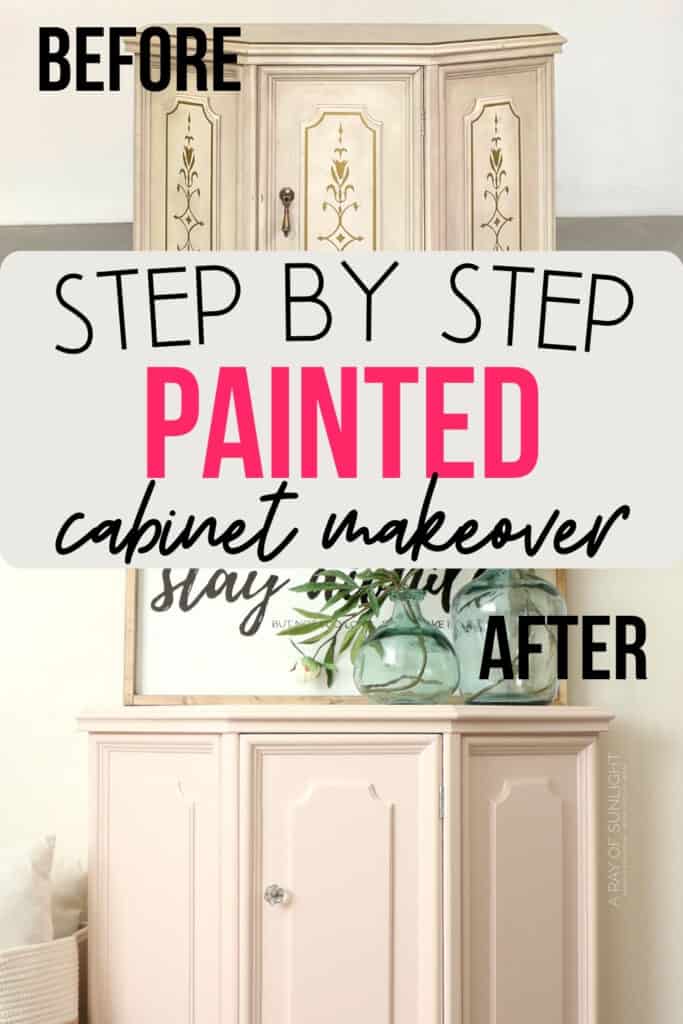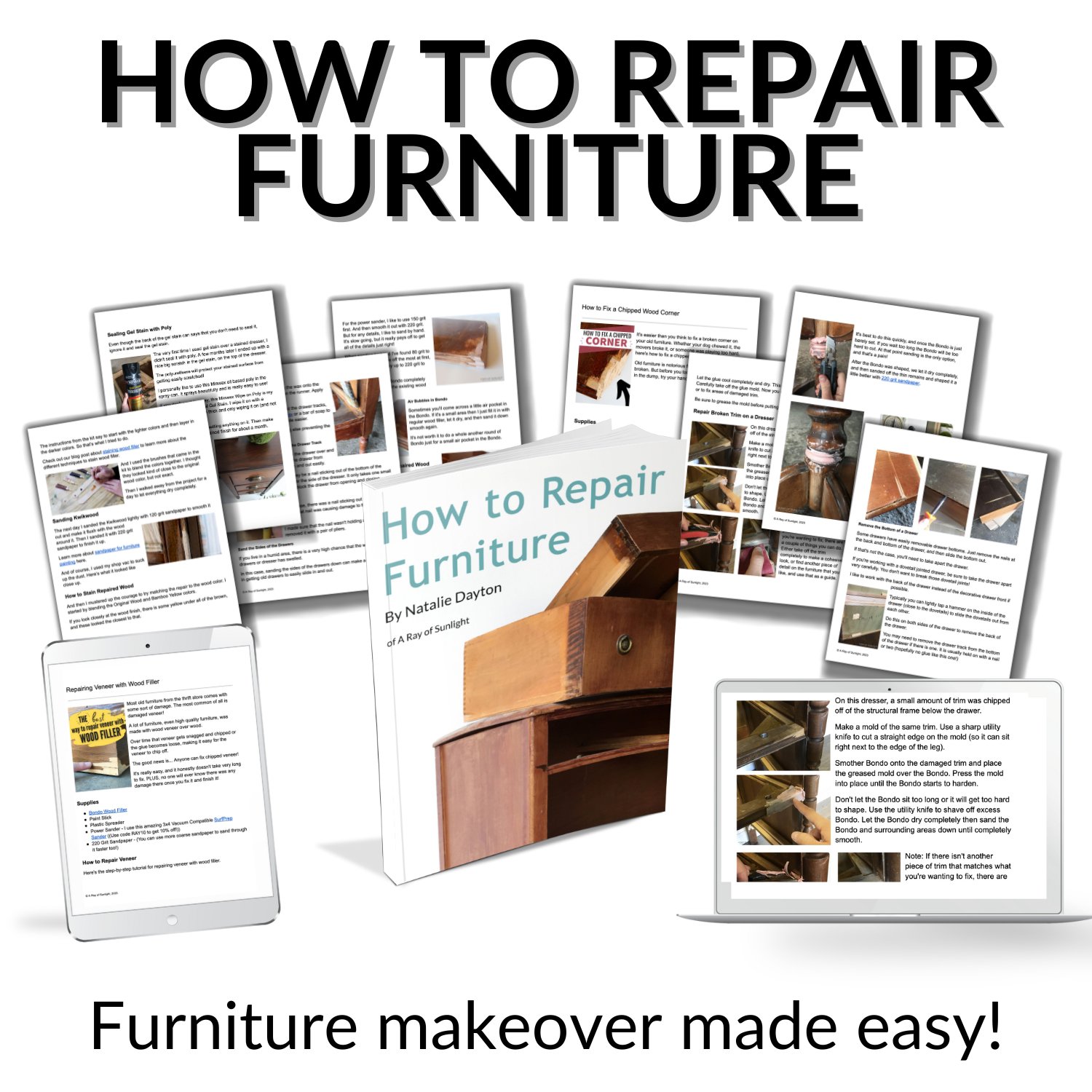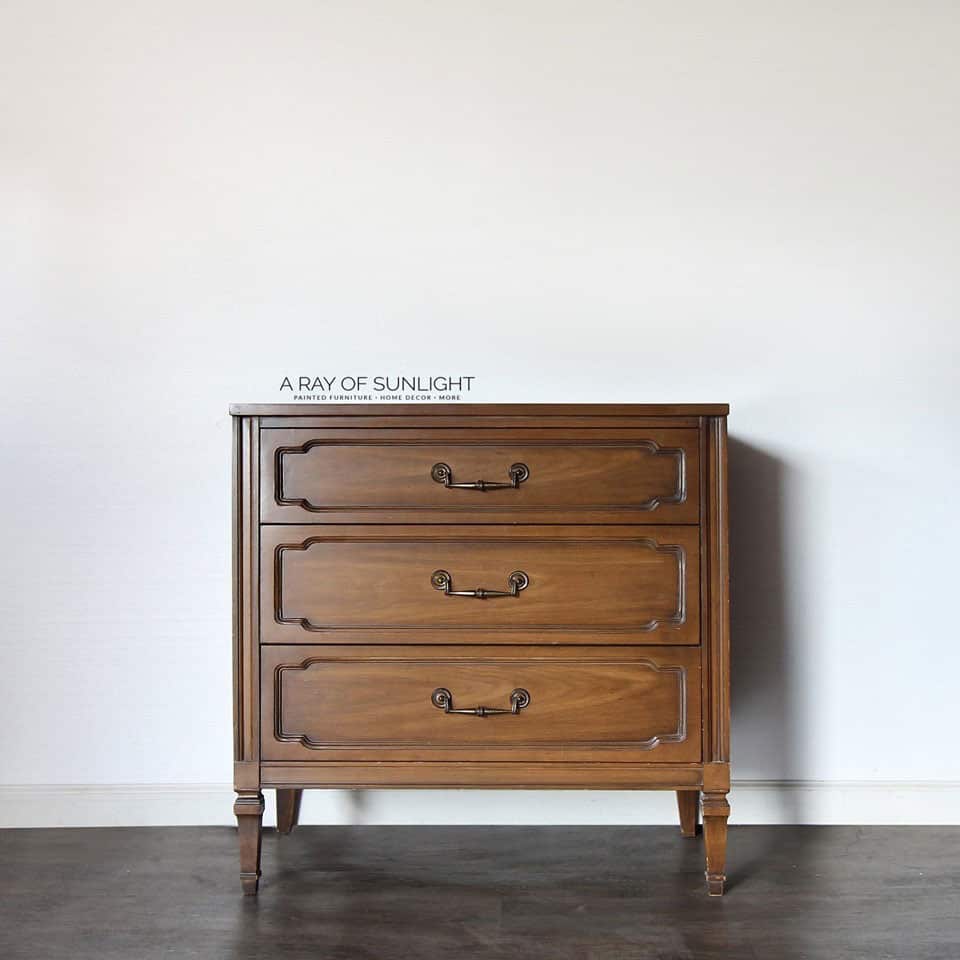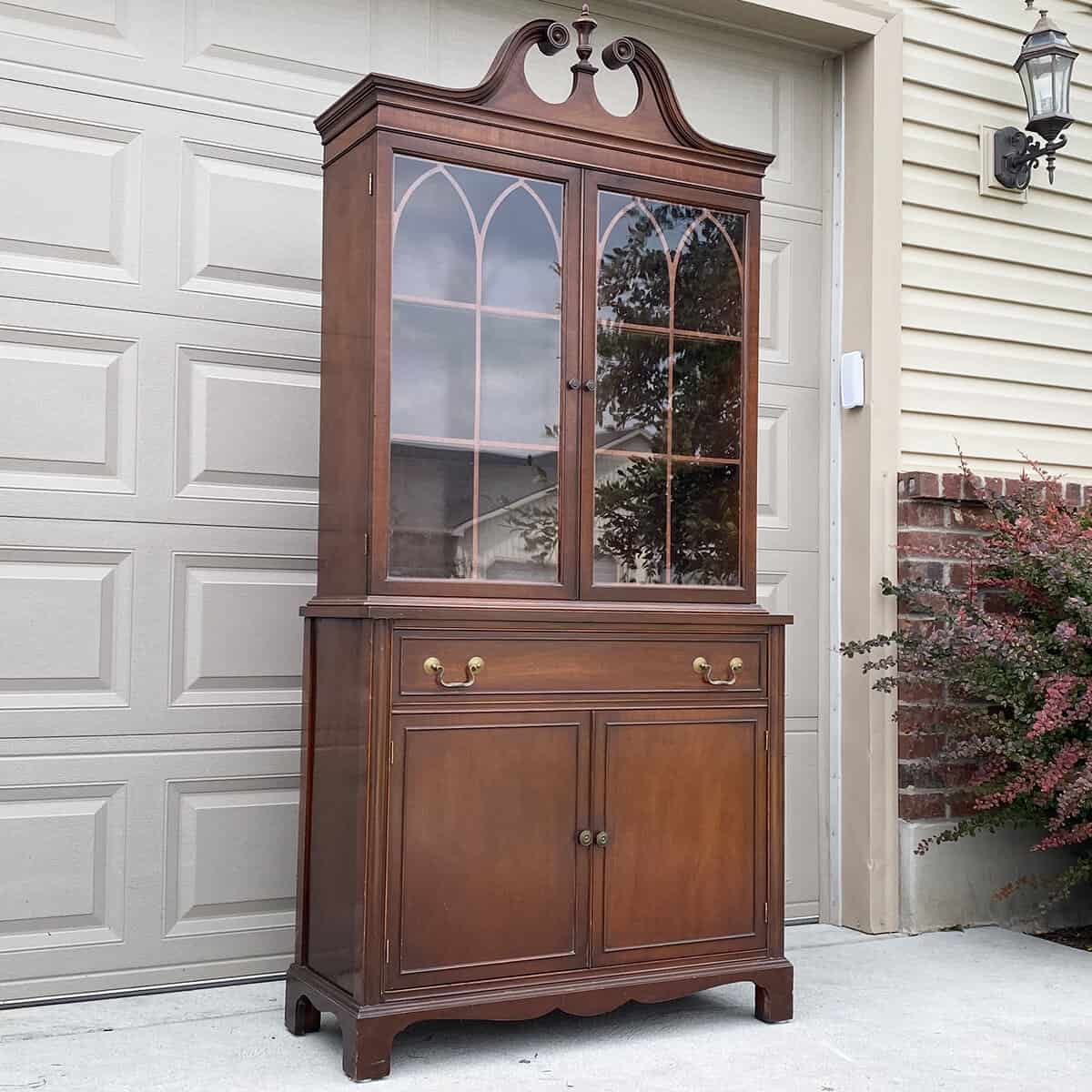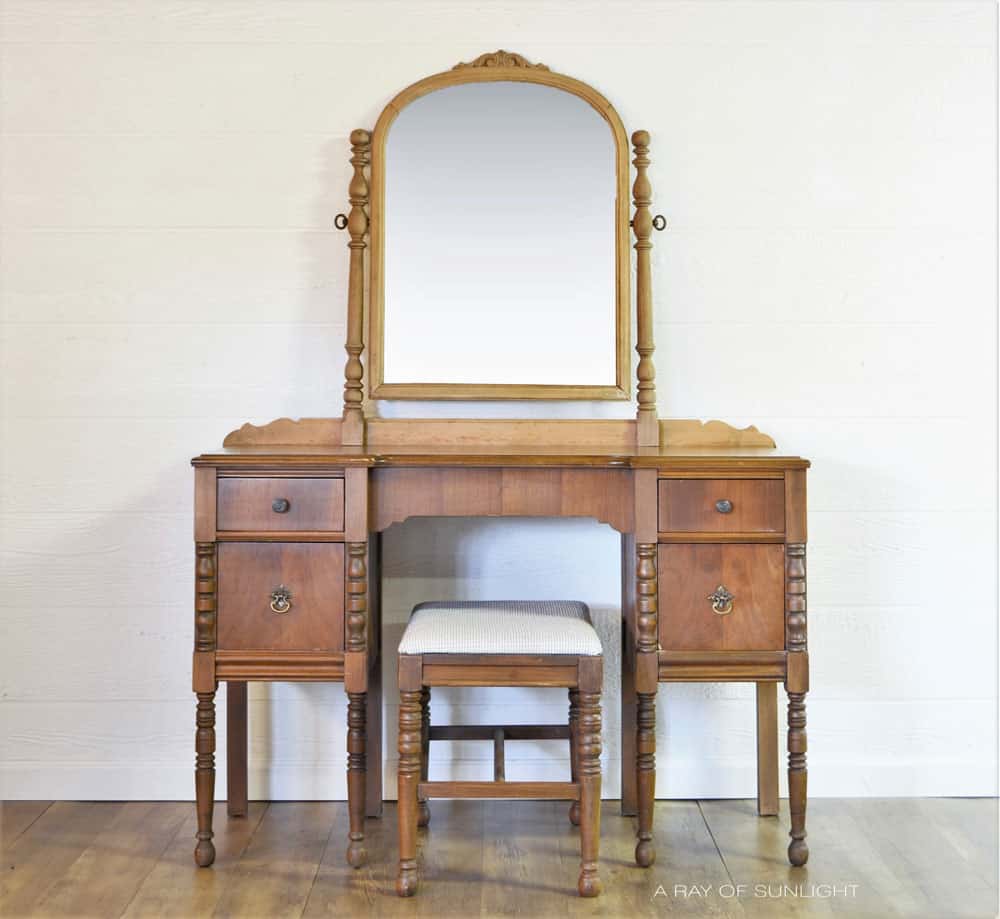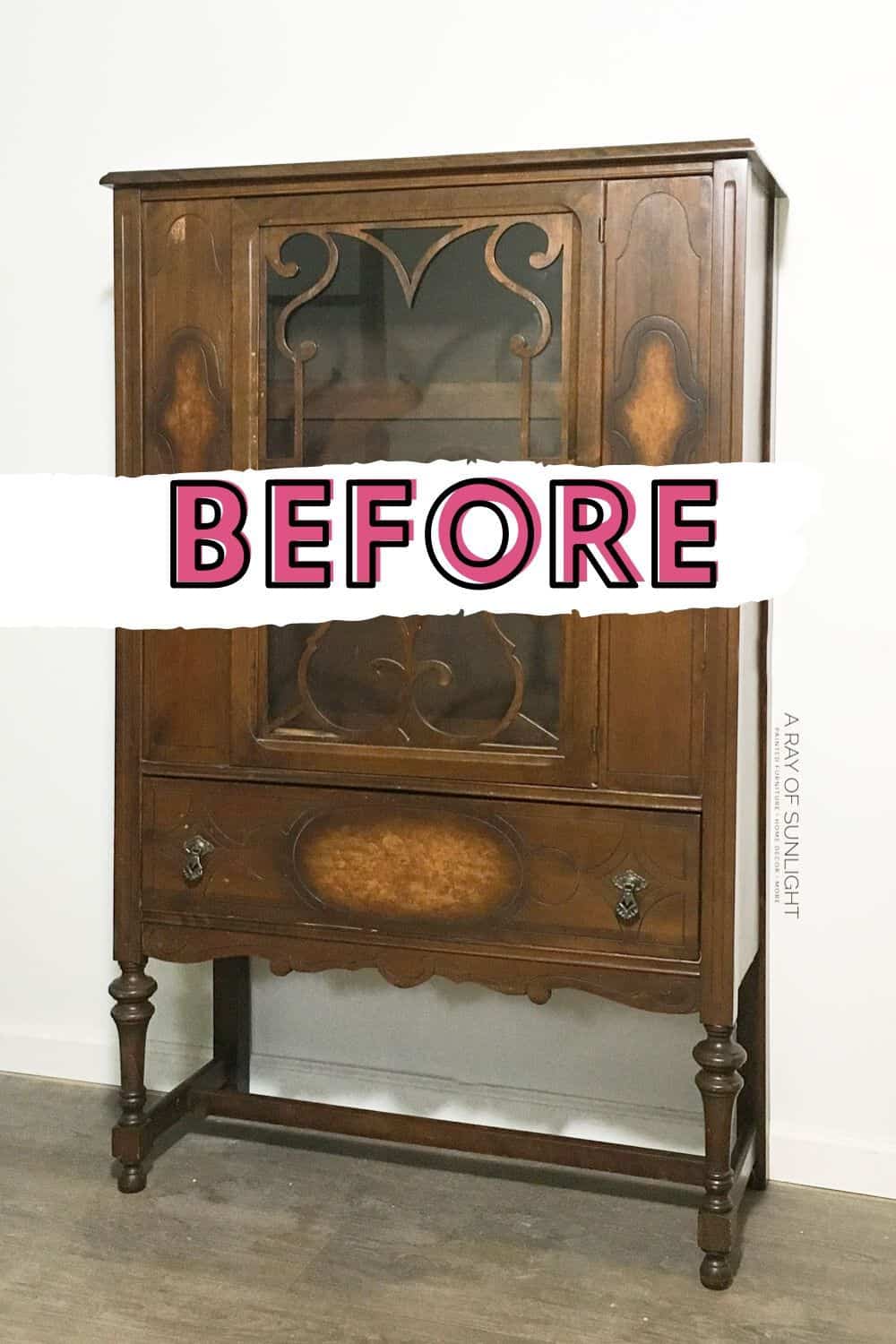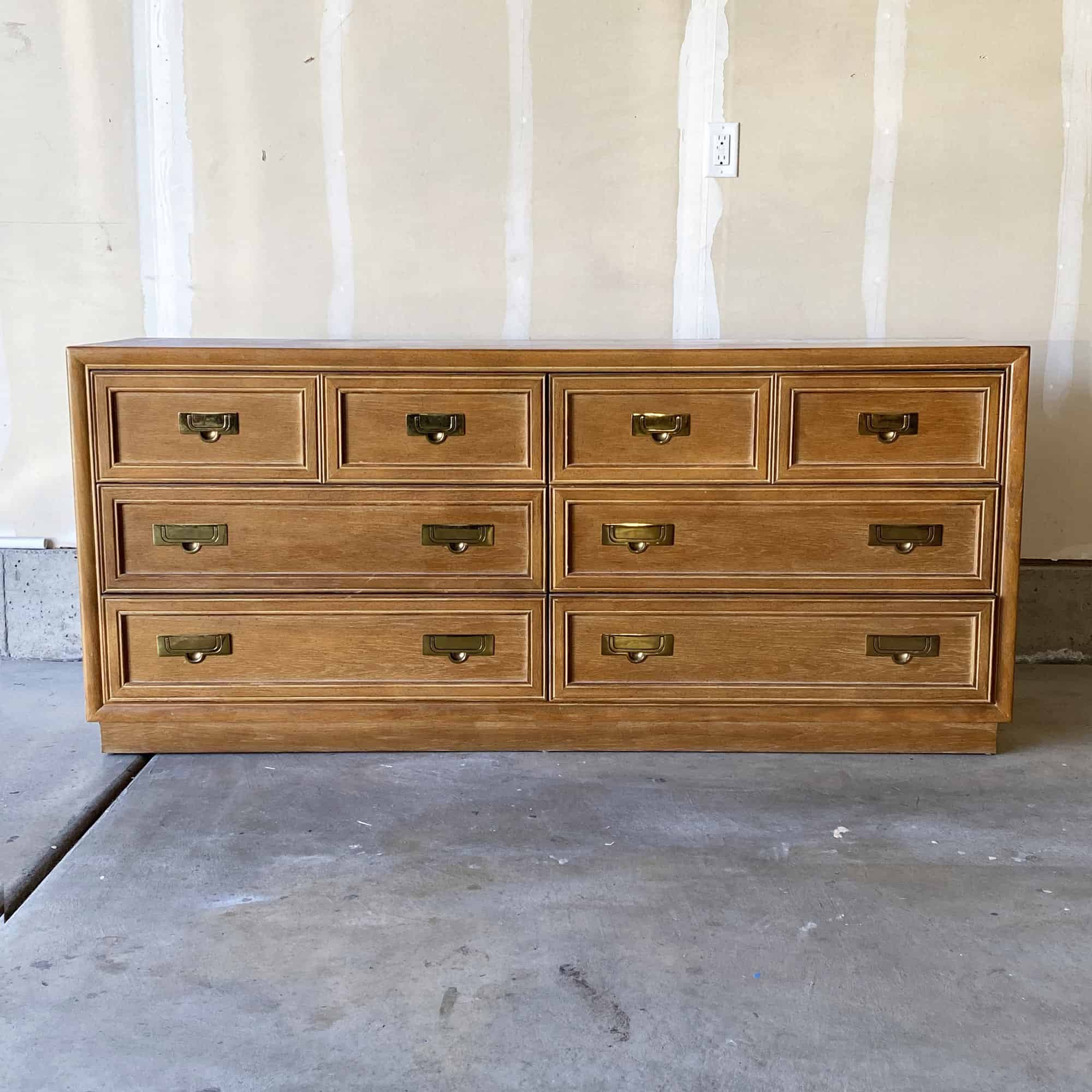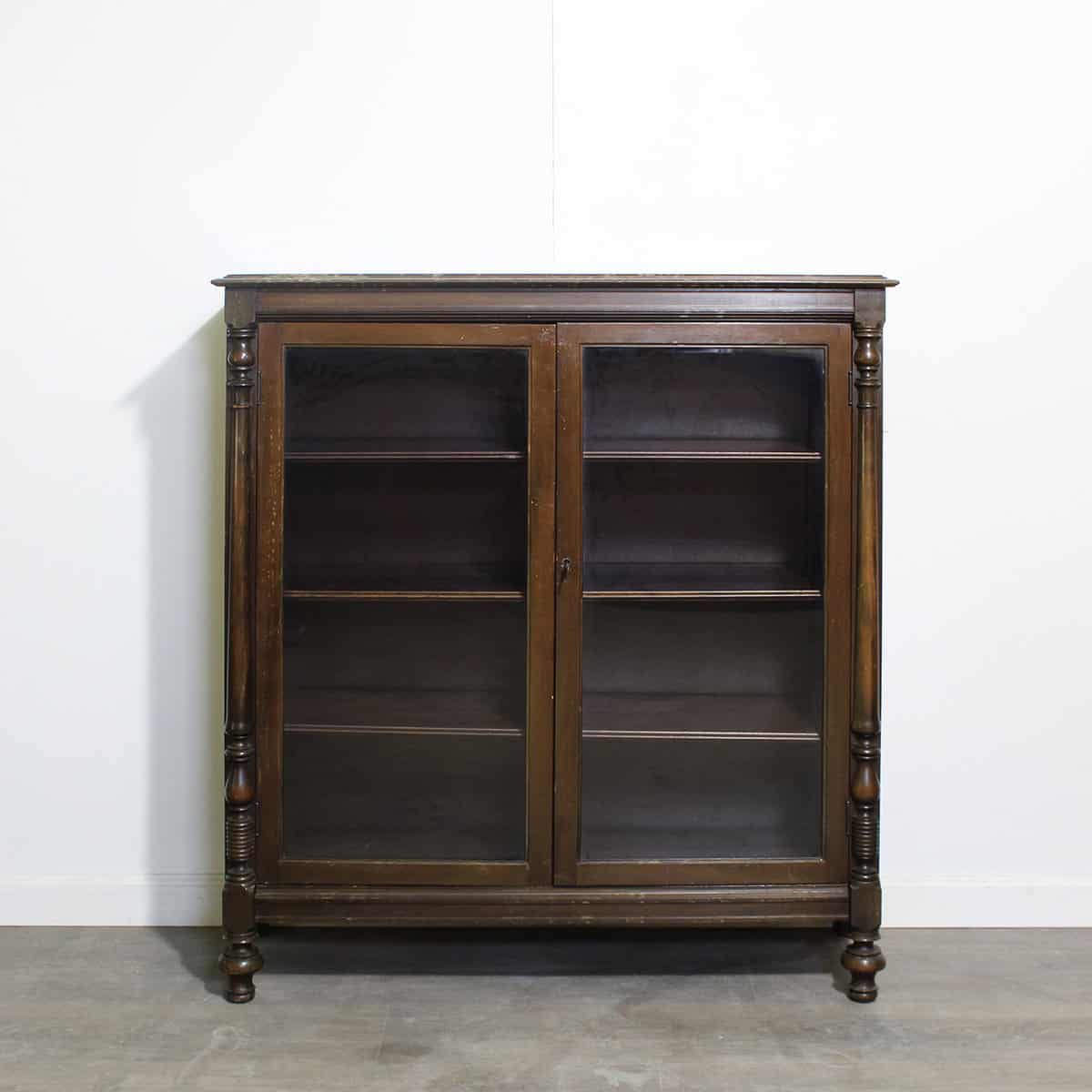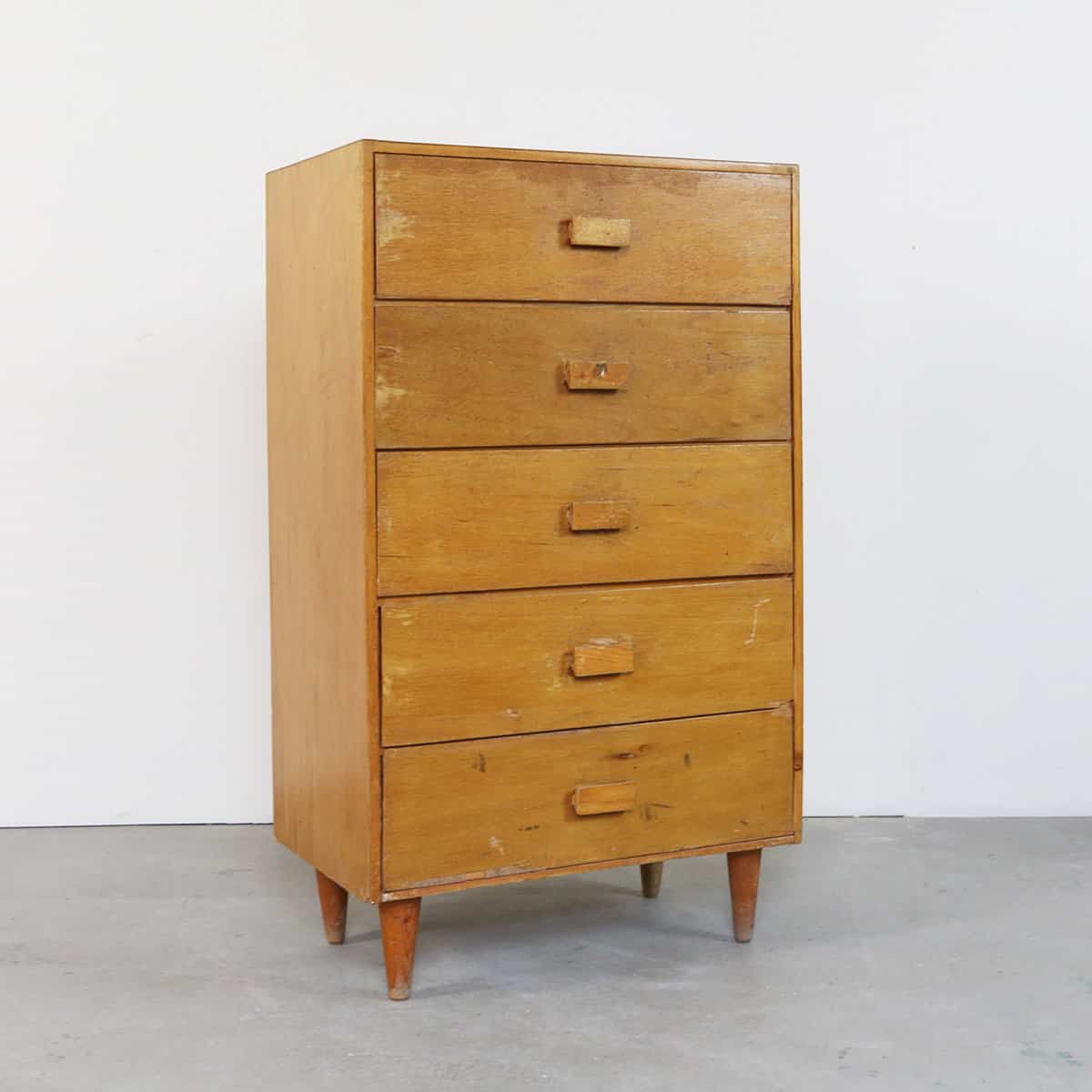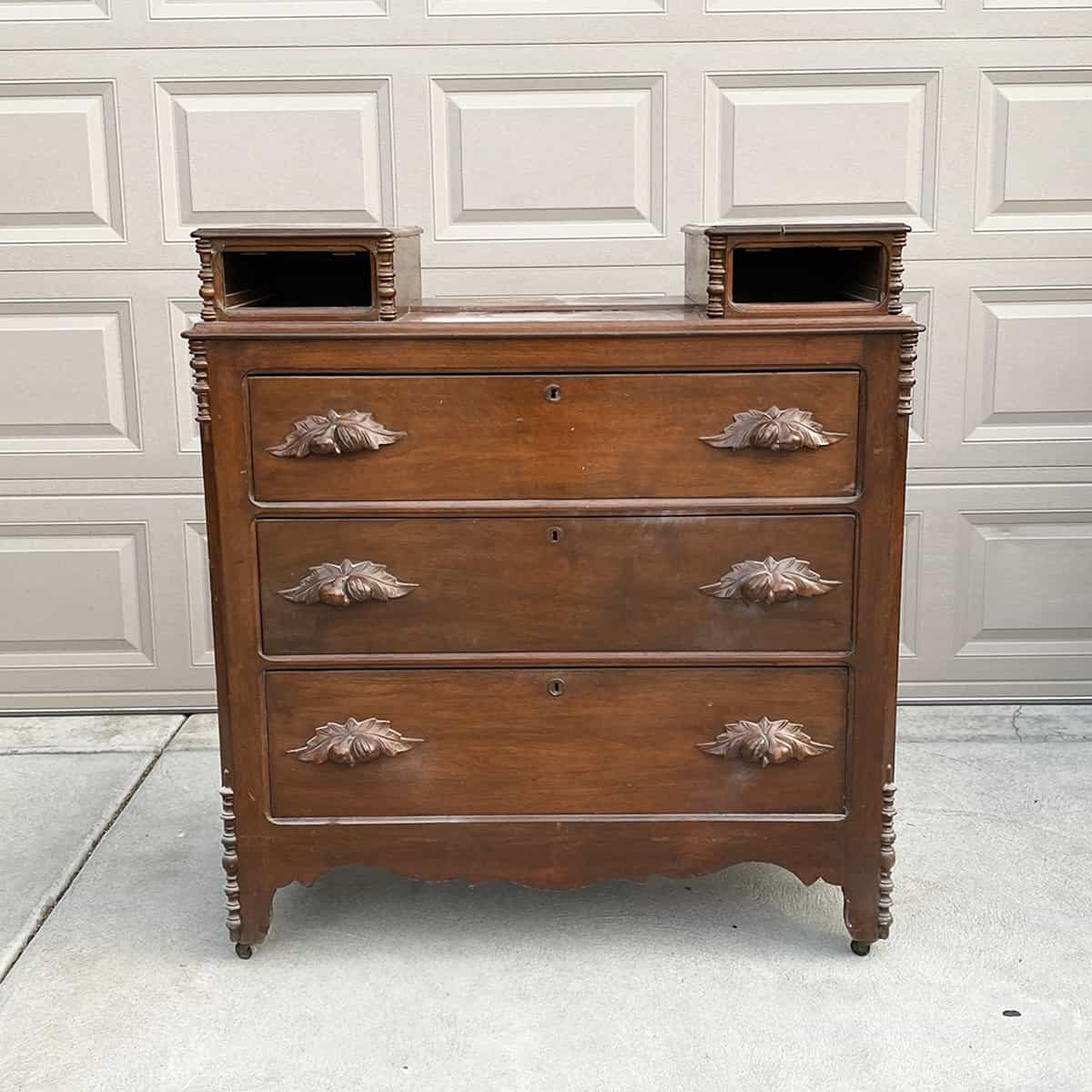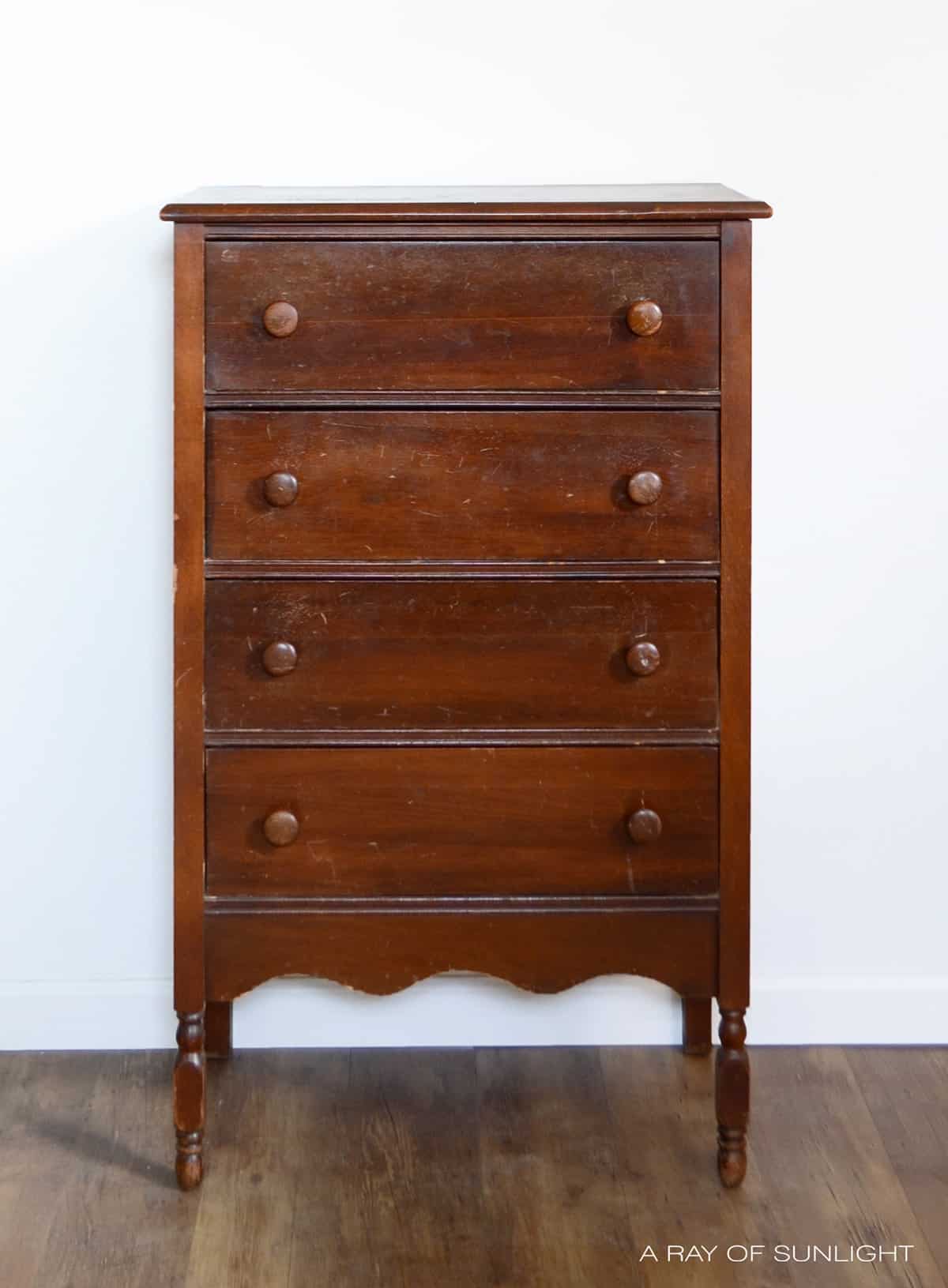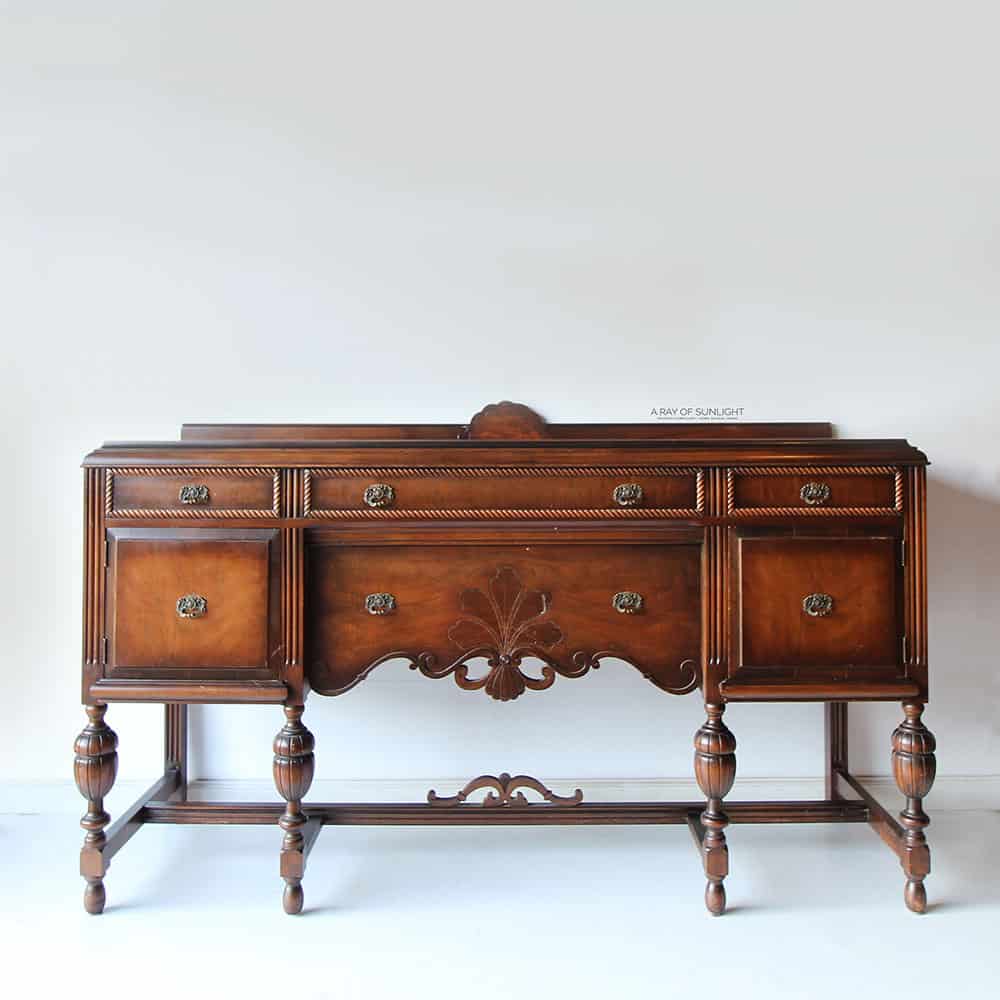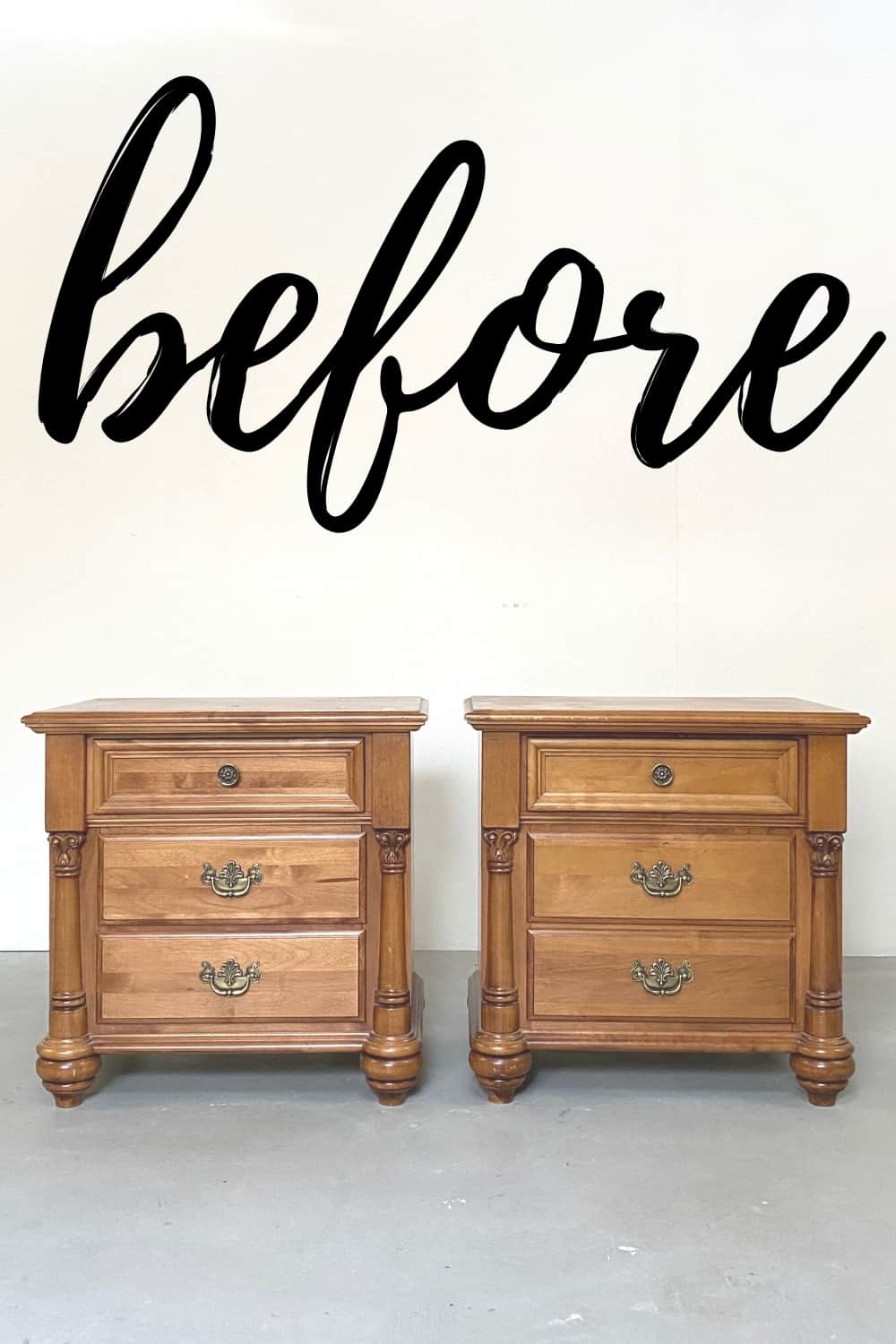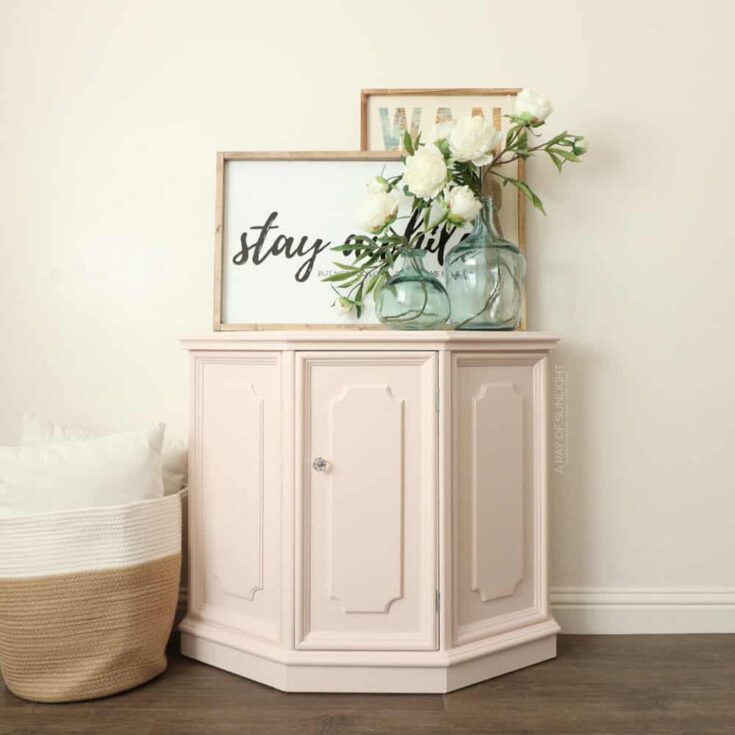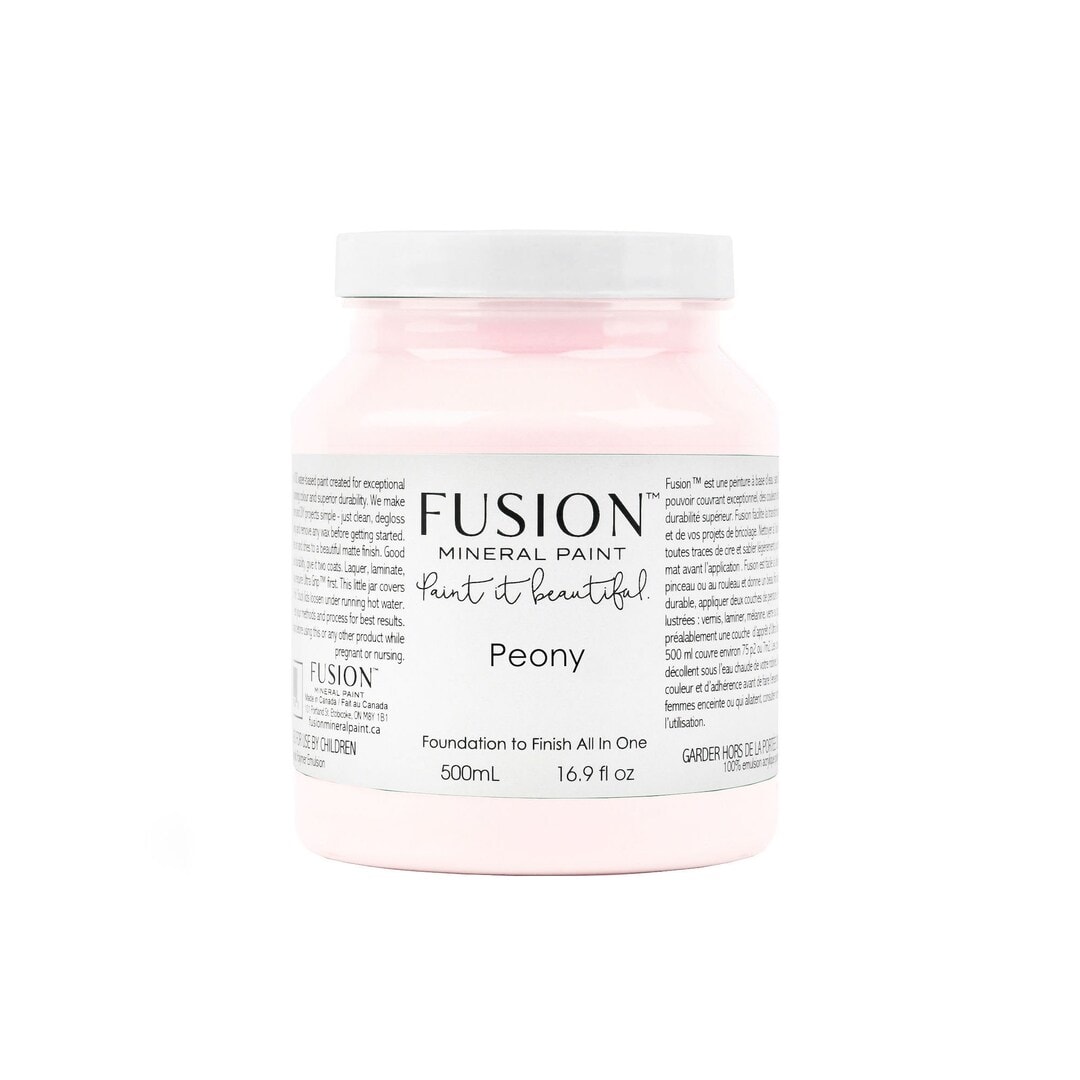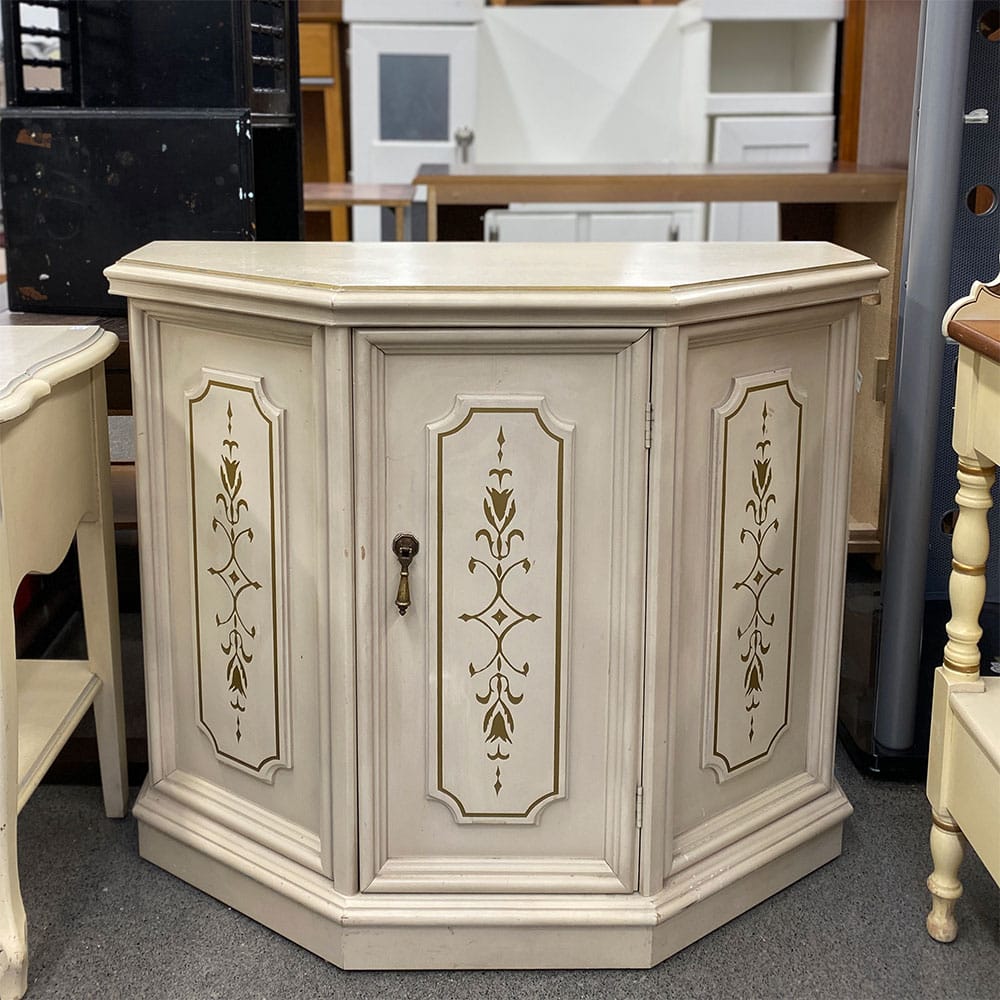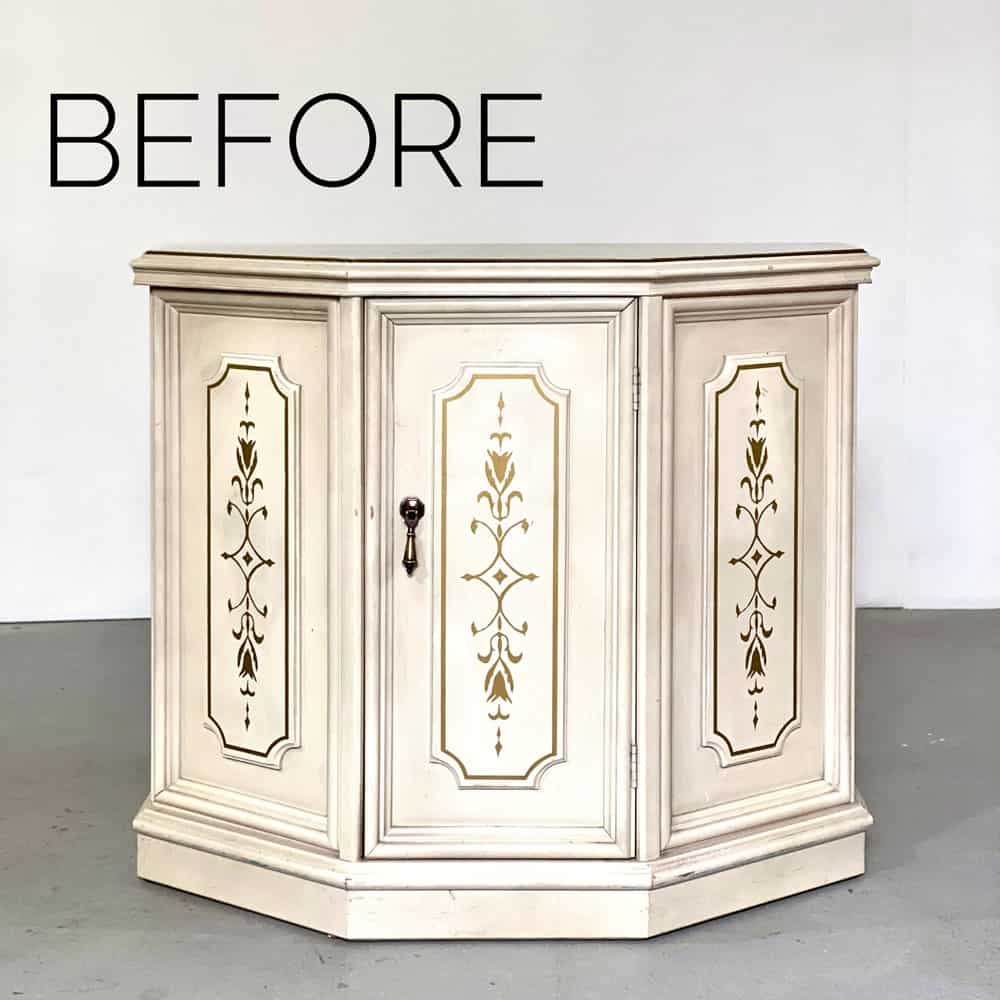Painted Hallway Cabinet Makeover
Check out how an old hallway cabinet goes from outdated to fresh and new with this step by step tutorial. Here’s our painted hallway cabinet makeover.
Get more furniture makeover ideas here!
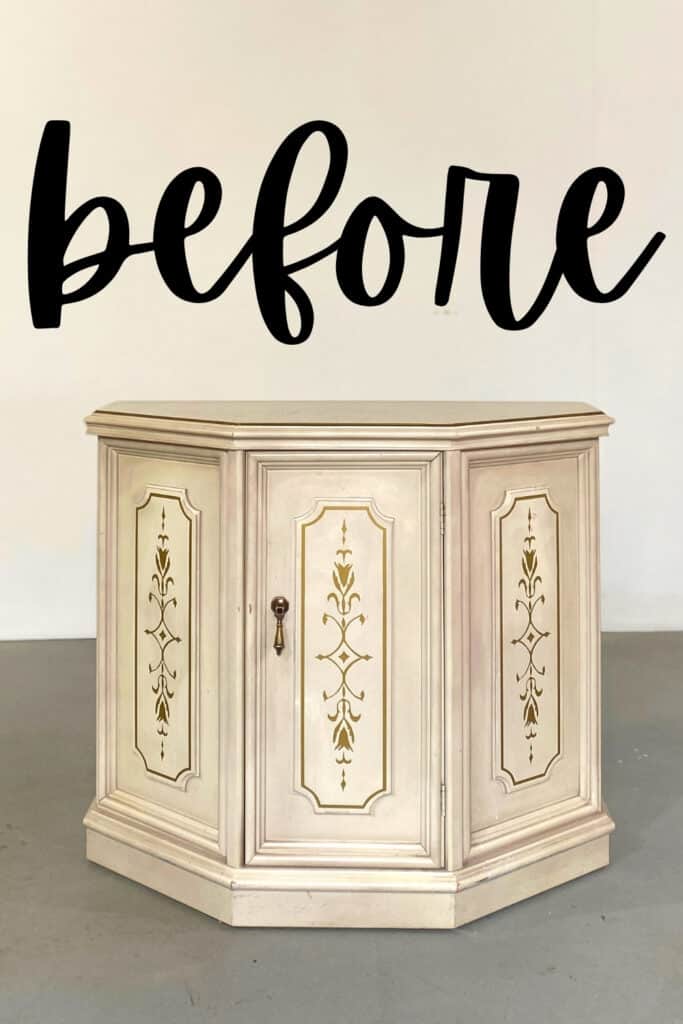
Here’s what it looked like before. We picked it up from our local thrift store. It was really dirty and the top had some damage to the finish.
But I think it would be a great little piece for extra storage in a small hallway or a bathroom. First, it needed a little update. Learn more about painting furniture to help you get started.
Supplies Used for Painted Hallway Cabinet Makeover
As an Amazon Associate, I earn from qualifying purchases. I also may earn from other qualifying purchases with other companies or get free product to review and use. All opinions are my own.
- Krud Kutter Cleaner Degreaser
- Old Rag
- 3×4 Vacuum Compatible SurfPrep Sander Use code RAY10 to get 10% off your order
- 220 Grit Sandpaper
- 400 Grit Sandpaper
- Shop Vac with Hose and Brush Attachment
- Tack Cloth
- BIN Shellac Based Primer (or the Spray Can Version)
- Mini 3/8″ Nap Roller
- Chip Brush
- Paintable Caulking
- Fusion Mineral Paint in Peony
- Fusion Mineral Paint in Cathedral Taupe
- Fuji Q4 Paint Sprayer
- Paint Filters
- Water
- Varathane Water-Based Polyurethane – My Favorite Topcoat
- New Knob
Remove Hallway Cabinet Hardware
First things first, I put it up on my workbench and removed all of the hardware, including the door hinges.
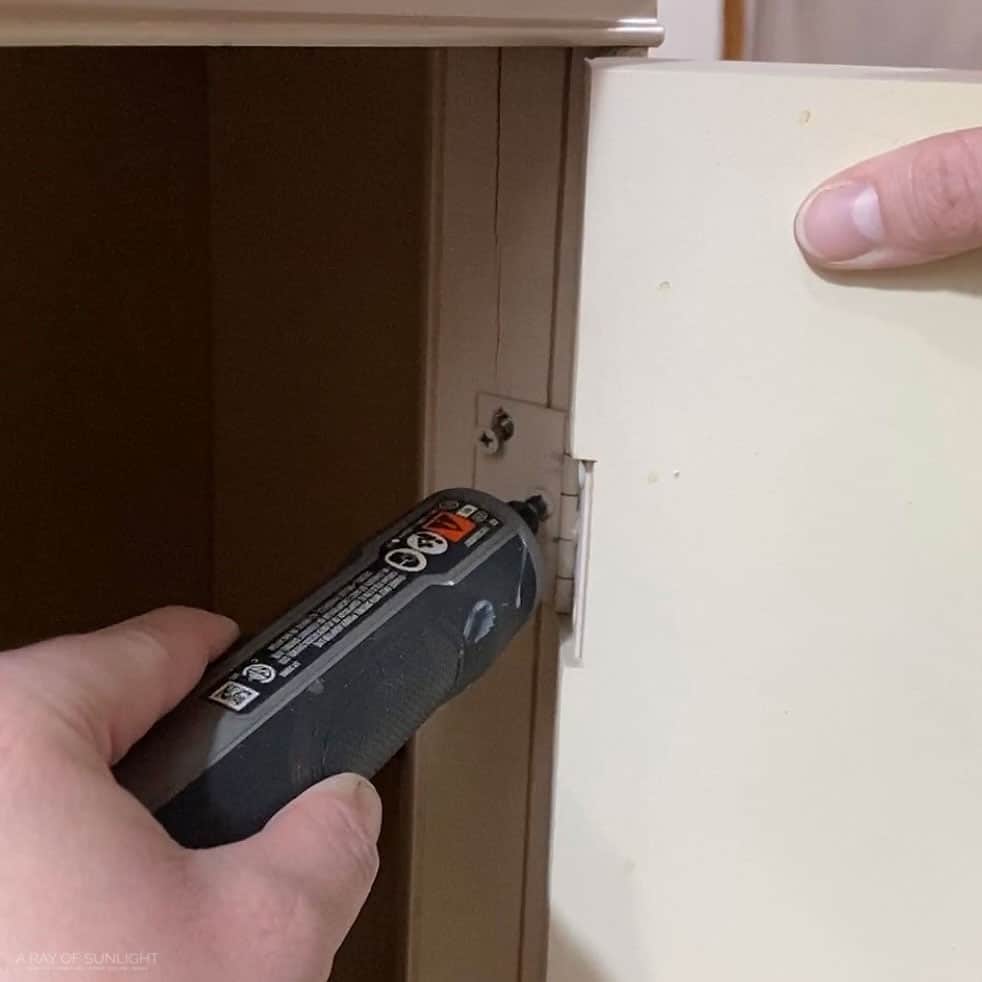
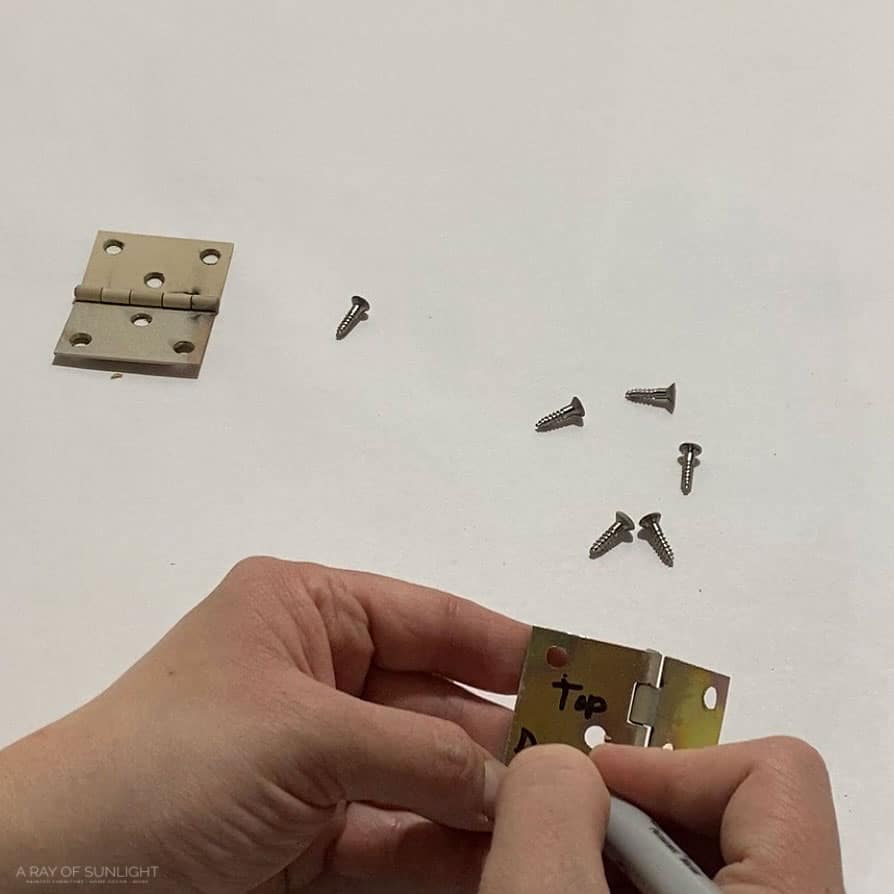
Hinges can be a mess to put back on, so I labeled them with a few details, including which one was on the top and which one went on the bottom, and which way they went on.
Then I put them in a container with the rest of the hardware. To better help you, read our post on how to prepare furniture for painting here.
Clean Hallway Cabinet
Next, I scrubbed the whole thing down with some Krud Kutter to make sure there wasn’t anything on the surface to prevent the new paint job from sticking.
This thing was pretty gross and as the spray sat, I could see the spray turning brown from all of the gunk. I cleaned it all a couple of times, including a rinse job at the end.
Check out this post to learn more about how to clean furniture before painting.
Scuff Sand Hallway Cabinet
Then, when it was all dry, I scuff-sanded it all down with my favorite little sander. Check out these best sanders for furniture to help you work with ease.
The scuff sanding is just an extra step to make sure the paint sticks really well.
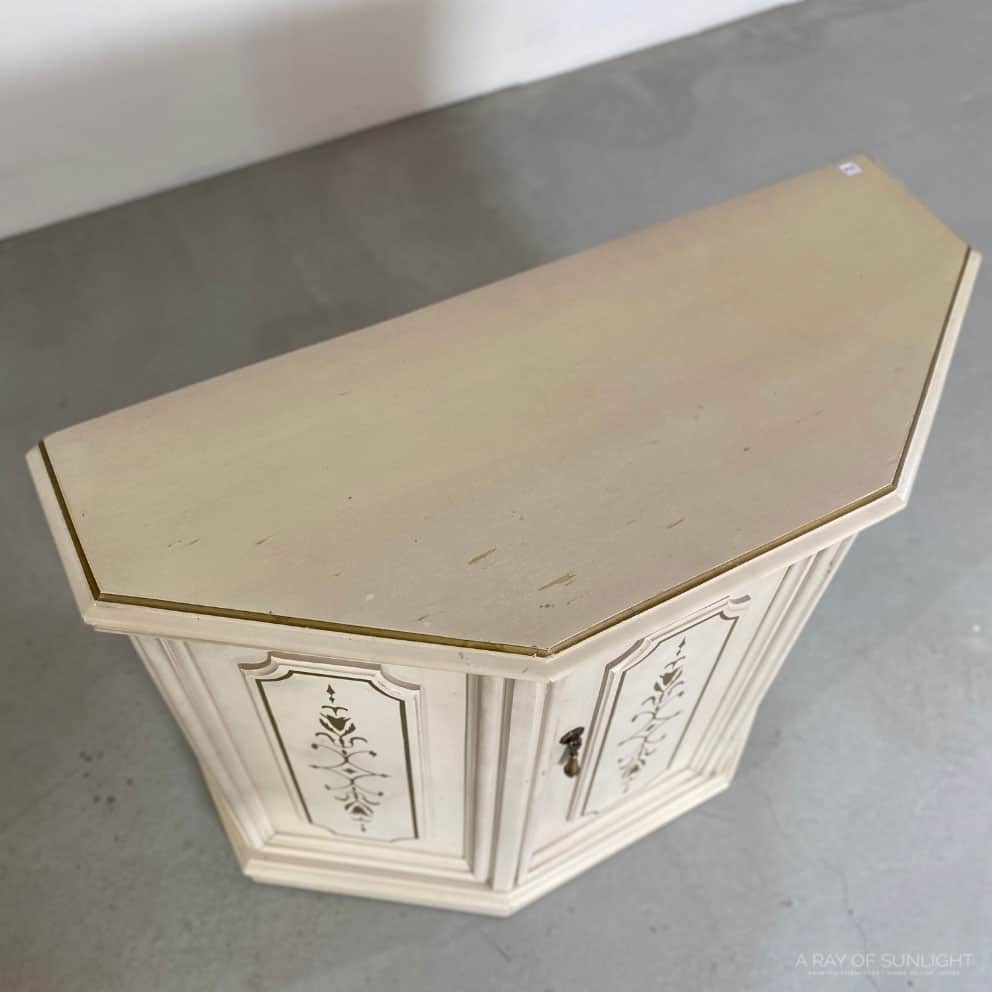
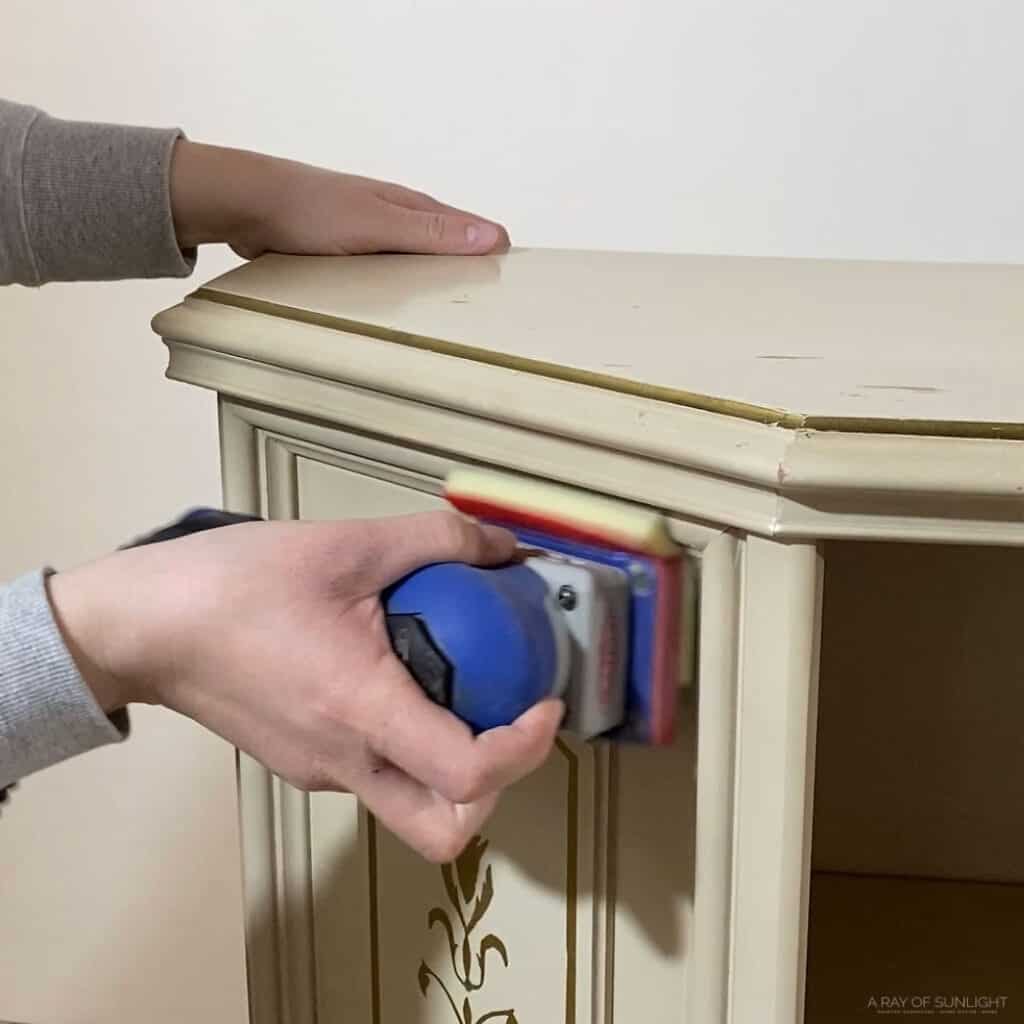
Before I got this little power sander, I used to scuff sand by hand with 220-grit sandpaper instead. Learn more about sandpaper for furniture painting here.
But man I sand a lot of furniture so this little sander has been a game changer for me.
When scuff sanding, there is no need to actually sand down to bare wood. You just want to remove any shine and dull the surface so the paint has a better chance at holding on.
Since the top had some damage, I sanded it down a little more, trying to sand those scratches out. Learn more about the importance of sanding before painting furniture here!
Then I vacuumed up all of the dust I created and wiped it all down with a tack cloth to remove any remaining dust.
These tack cloths really are amazing at picking up every little last speck of dust and are so much better than just a lint-free rag.
Prime Hallway Cabinet to Block Bleed Through
Since I wanted to paint a light color, I wanted to make sure that I wouldn’t have any bleed through issues where the wood underneath stains through the paint.
So I busted out some BIN shellac-based primer and brushed and rolled it all over.
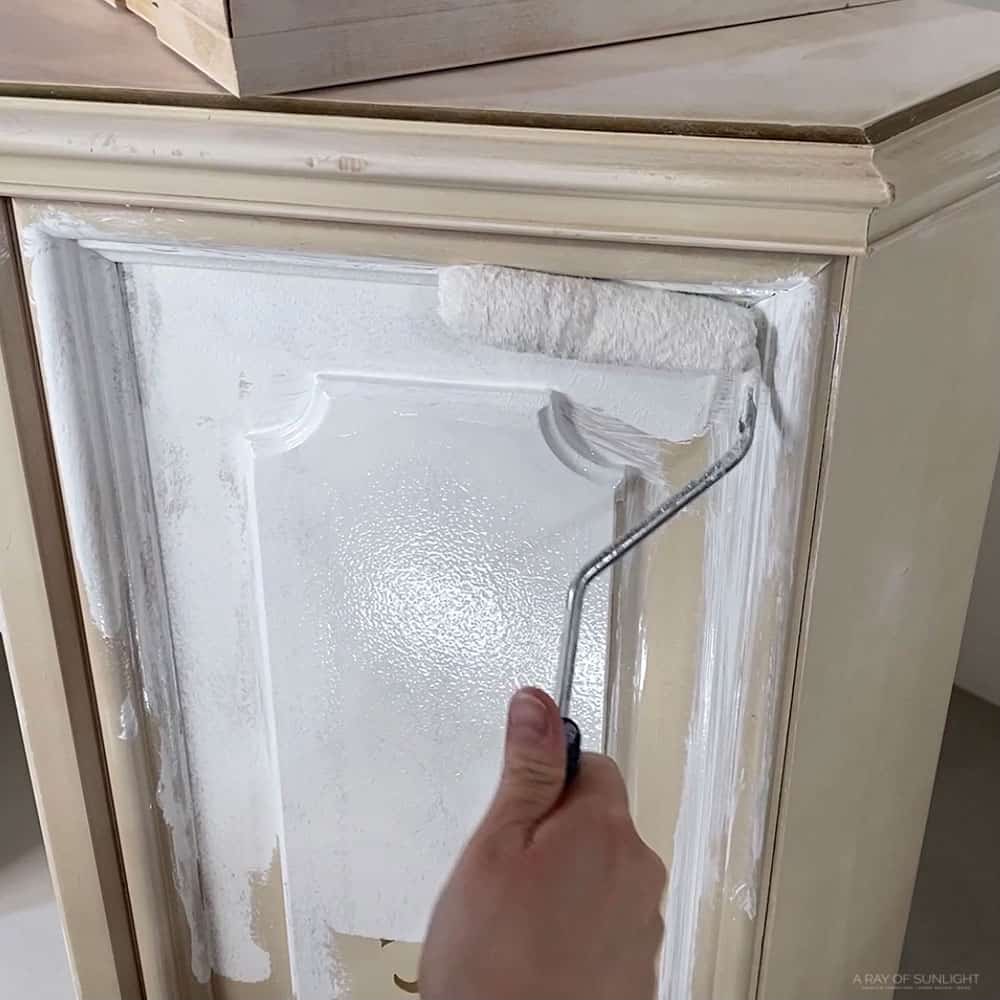
Honestly, I completely regretted my decision to brush and roll the primer on. I wish I would have taken it outside and sprayed it with the BIN shellac in a spray can instead.
Even though I used a nice roller, I still had a lot of texture from the roller, and it just took FOREVER to roll it on instead of spraying it on.
But if rolling on primer and paint is your only option, check out this post about the best rollers for painting furniture to help you get the best possible results.
So, next time, it’s back to the spray version of the primer instead! Learn about the best primers for painting furniture (and how to choose the right one) here.
After about an hour the primer was dry, so I sanded the primer down a bit with 220 grit sandpaper to remove the texture it created.
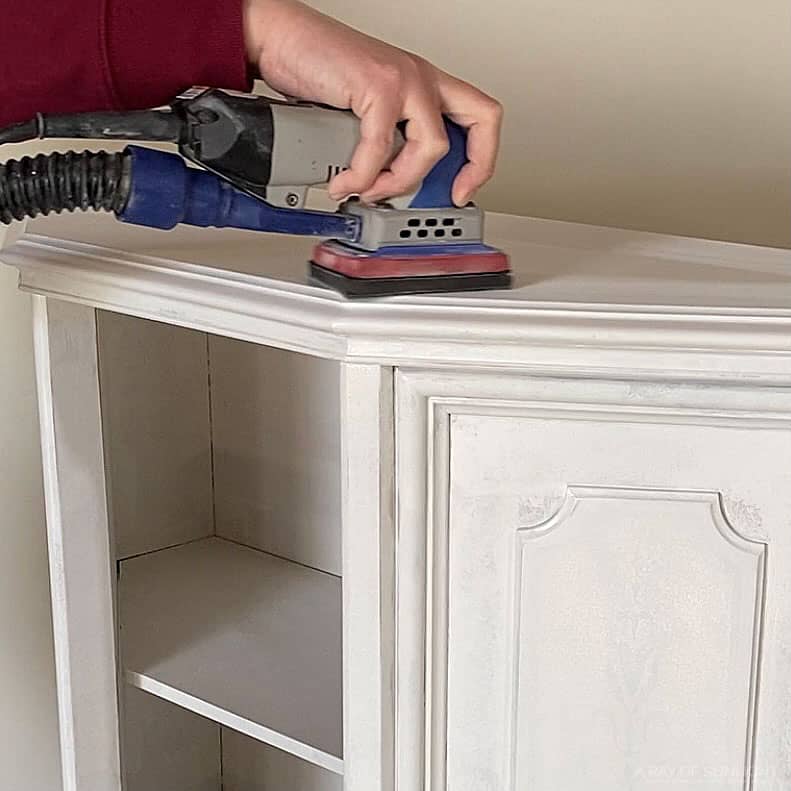
Then I removed the dust with the vacuum and tack cloth. And painted on another coat of primer and let it dry.
Caulk Seams
With the white primer on, I noticed a few seams that were really showing up, so I filled them in with some paintable caulking. This is totally optional and something I don’t do all the time.
But sealing up those dark seams makes the end product look so much better in the end.
I squeezed it on and then used my finger to push it into the seams, and then I used a damp rag to remove the excess caulking. For other repairs, check out the best wood fillers for furniture here.
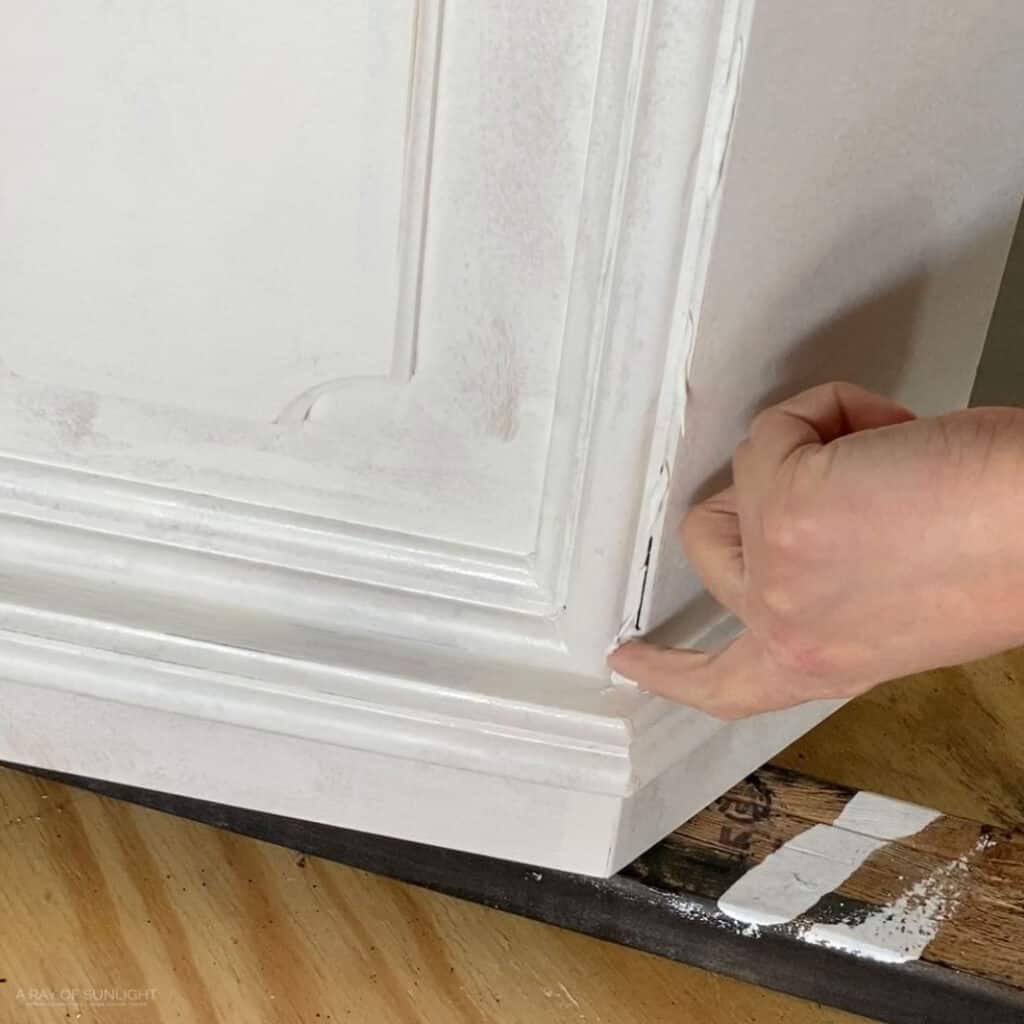
Caulking isn’t easy to sand down, so I really wanted to get it wiped off before it dried.
Paint Hallway Cabinet
For the paint, I used a couple of paint colors that I had on hand. I mixed Fusion Mineral Paint’s Peony and what I had left of Cathedral Taupe together to create a more muted pink.
It was probably about a 20 to 1 ratio. (If I had more Cathedral Taupe I would have put more of that in with the same amount of Peony.)
Putting the Paint in the Sprayer
I mixed them up in my paint sprayer’s container, making sure to filter the paint before it went into the container, so I didn’t get any debris that could clog the sprayer in there.
Then I mixed in some water to thin the paint out a bit.
With this sprayer, I don’t measure how much water to paint I use. With my cheap paint sprayer I definitely measure the water and paint to make sure the sprayer can spray it.
Fusion Mineral Paint seems to need to be thinner than other furniture or chalk paints that I use in my sprayer too. Here are the spray paint tools that you need when spray painting.
Spray Painting Hallway Cabinet
Then I sprayed my cabinet with a few coats of the paint. Learn the tips and tricks of painting furniture with a sprayer here.
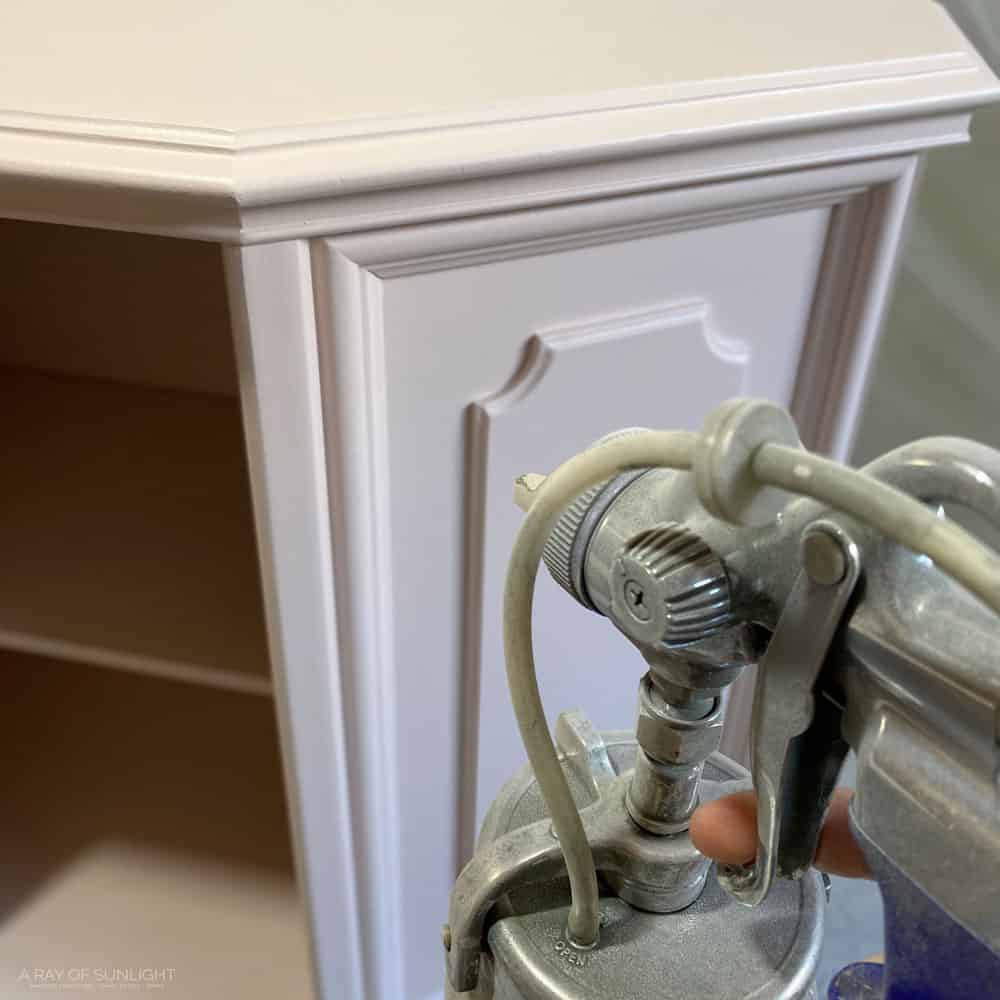
I let it dry for about 2 hours in between each coat, and I also sanded in between each coat to knock down some texture that was left behind.
Check out this Fusion Mineral Paint review to learn more about the pros and cons of this paint.
Brushing Paint Instead of Spraying
You can also brush this paint on instead. Personally, I really like the Staalmeester paint brushes with Fusion Mineral Paint. It’s the best way to get a brush-free finish with their paint!
But if you don’t want to spend the money on their pricey paintbrush, I would recommend brushing it on with a Zibra round paint brush.
The Zibra round paint brush gets into details, molding, and trim so much easier than a flat brush. And Zibra brushes are high quality at a very reasonable price!
Read more about the best paint brushes for painting furniture here.
Topcoat Painted Hallway Cabinet
Fusion Mineral Paint is a very durable paint that dries in a matte finish and technically doesn’t require a topcoat. Check out the best all-in-one paints for furniture here.
But if you’ve been around here for any time, you might notice that I still topcoat paints like this, just for extra durability. Check this post to learn more about topcoats for painting furniture.
I mean, if I’m going to go through all of this work, I’m going to do what I can to make the finish be as durable and long-lasting as possible.
So, after the last coat of paint was dry, I sprayed on 3 separate coats of my favorite clear, water-based poly.
I also sanded in between the coats of poly with 400 grit sandpaper to make sure the finish was silky smooth when I was done.
Get the Secrets!
Grab this super convenient How to Repair Furniture Ebook with all of our secrets on how to repair furniture for only $14.
You can print it out and have instant access whenever you come across damaged furniture, and know exactly how to fix it!
Click on the picture of the book to purchase!
Add Hallway Cabinet Hardware
The next day I put the cleaned-up hinges back on and a new knob. But if you want to keep the old hardware, here’s how to clean old furniture hardware to bring back its shine.
Check out this video on YouTube for the whole makeover.
And here’s what it looks like now!
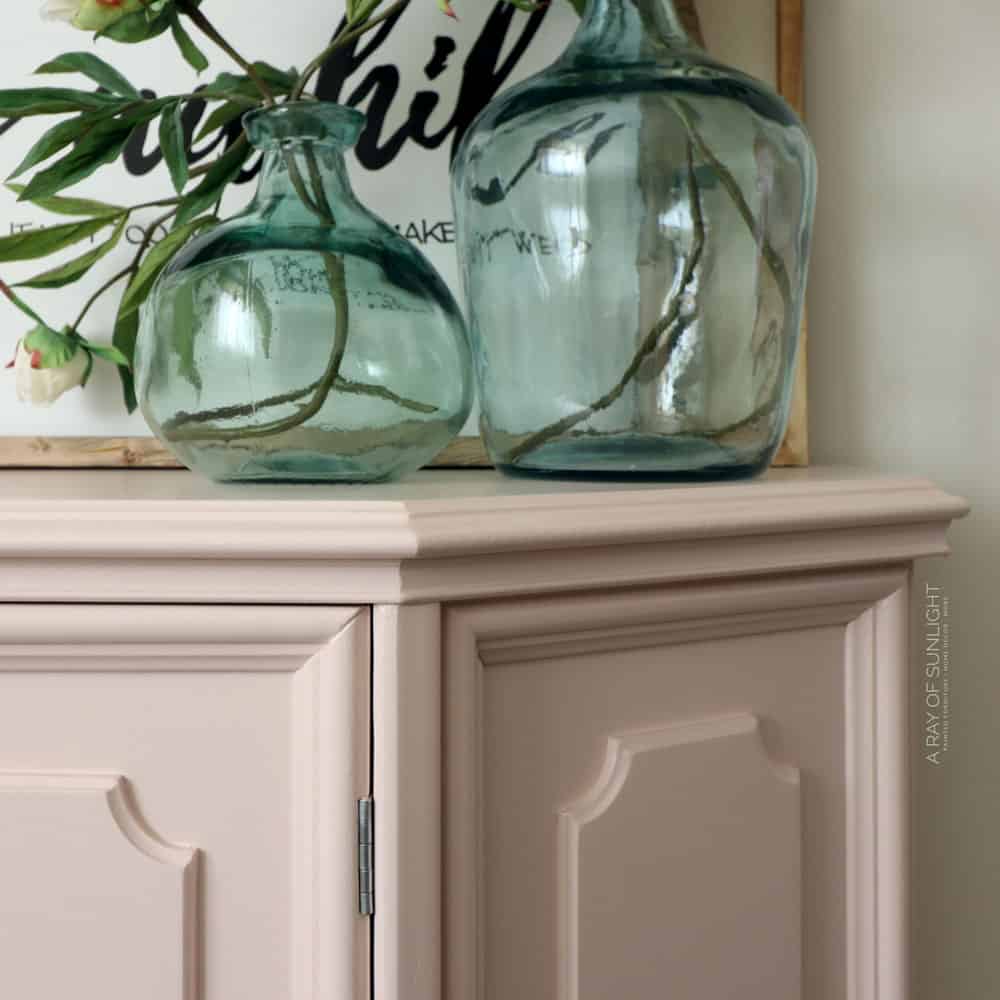
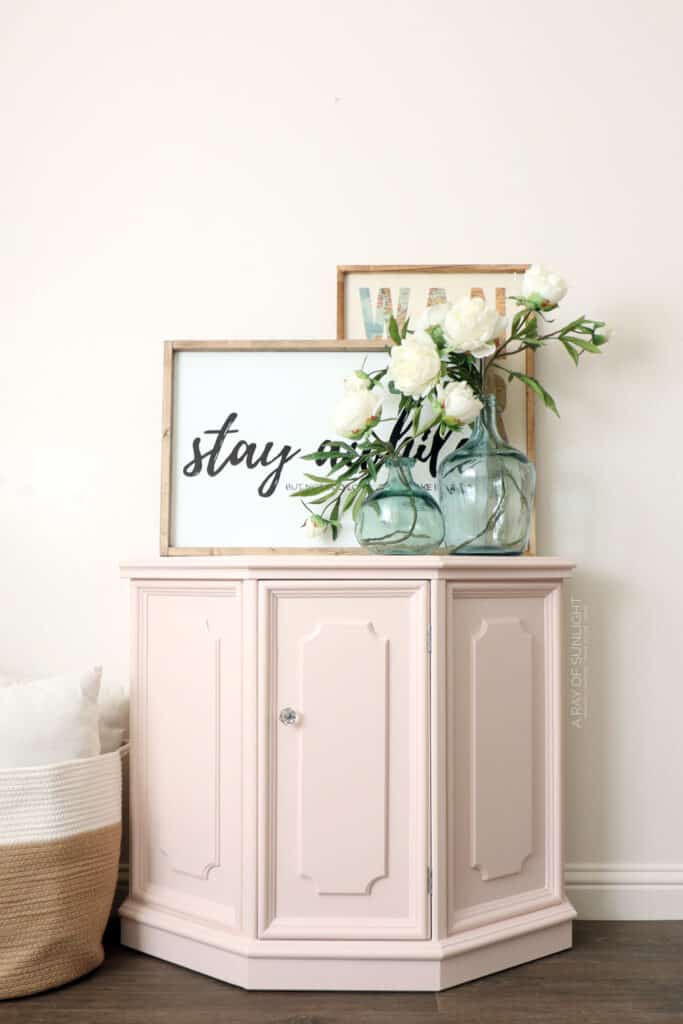
More Before And After Makeovers
Click any of these “before” photos below to view the “after” of that makeover.
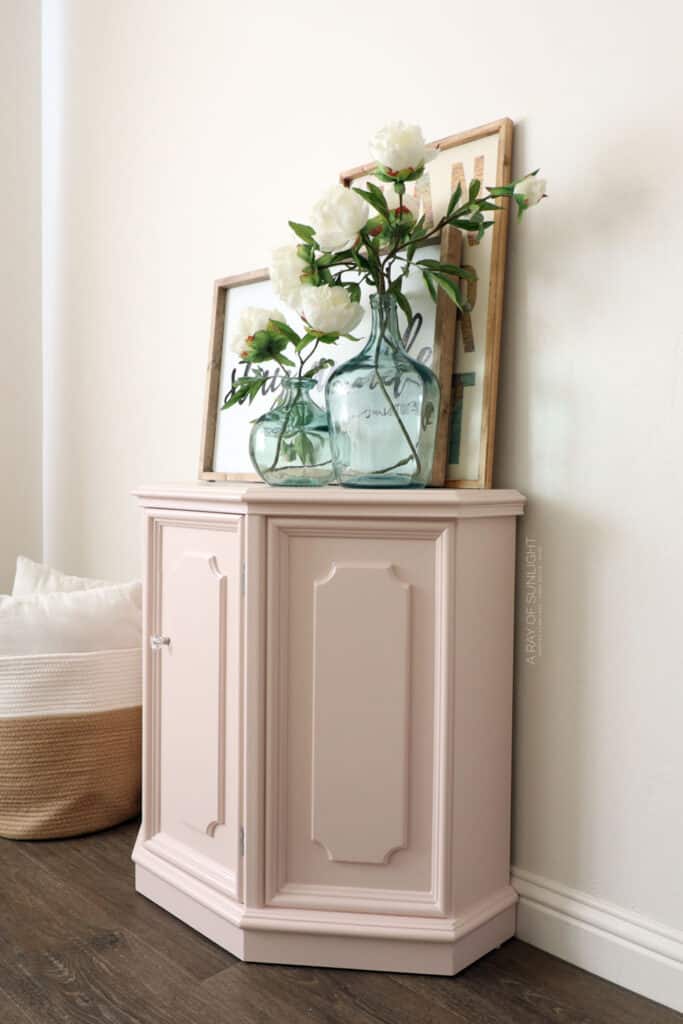
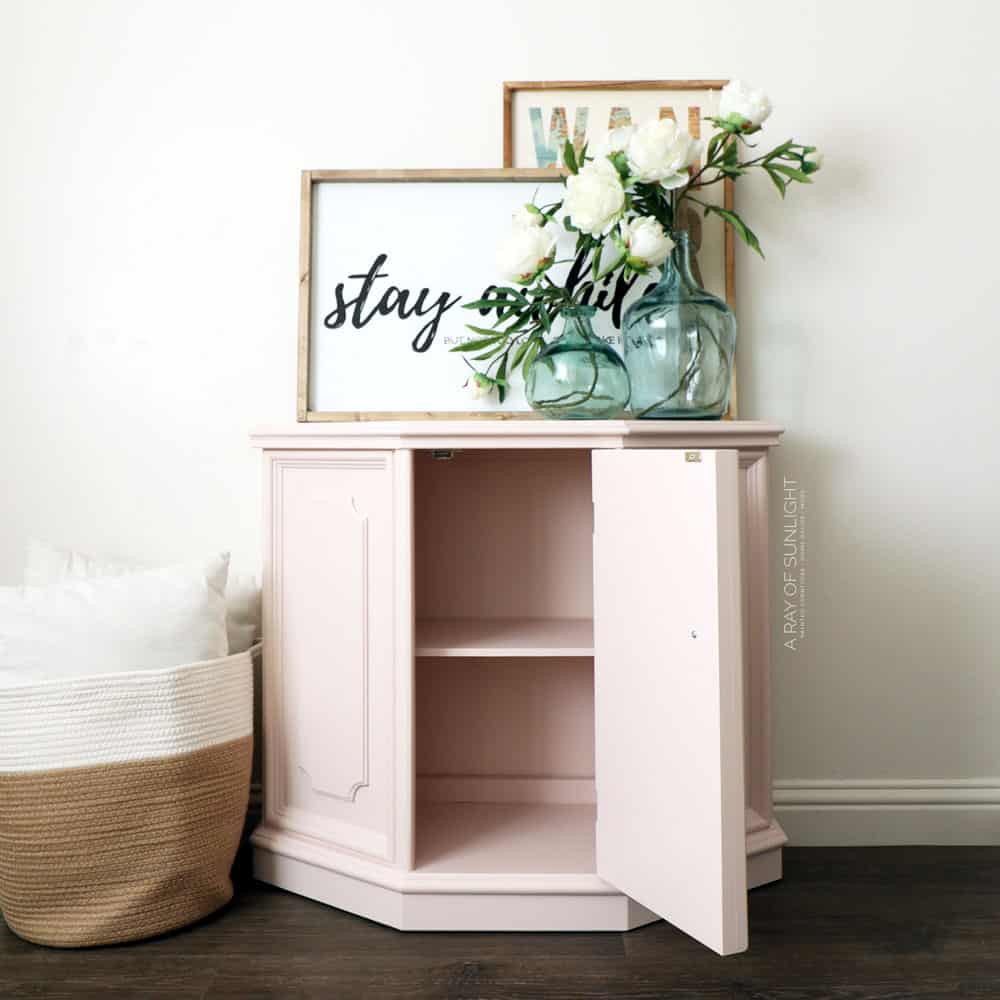
Goodbye old outdated finish, hello modern paint job!
More Pink Painted Furniture Ideas
- Pink Vintage Dresser
- DIY Pink Dresser
- Chalk Painting Furniture
- Pink Painted Furniture Ideas
- Pink Painted Nightstand
Follow us on YouTube to get more tips for painting furniture.
Or share your project with us on our Facebook Group and be part of our community. See you there!
